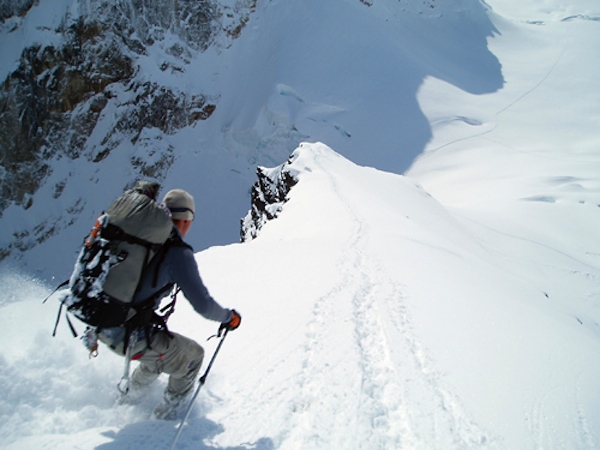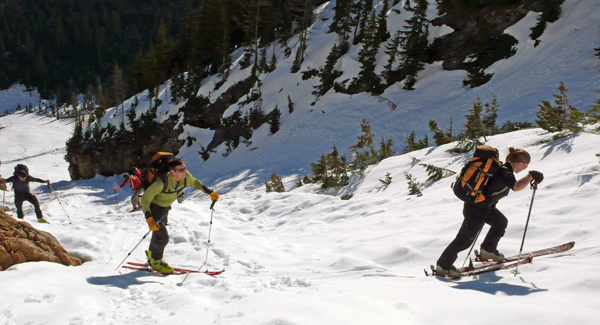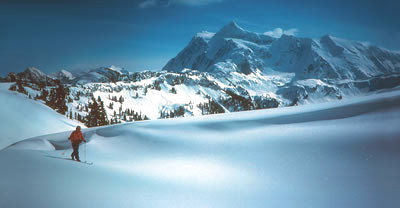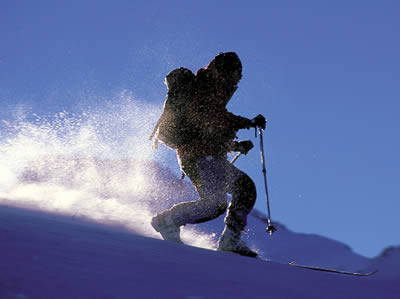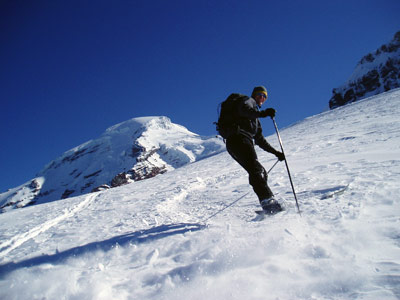Ski Mountaineering Overview The glacial environment is one of the most beautiful that the mountainous regions of the world have to offer, and glacier skiing gives adventurous people the combined rewards of remarkable spring high country beauty and the elation of descending pristine slopes where almost no other skiers venture. For climbers, glacier skiing ability also gives them easy access and quick descent in the early season, turning trips that would otherwise be laborious journeys through soft snows into enjoyable and exciting adventures.
We offer a 6-Day Ski Mountaineering Clinic, which takes place on Mt. Baker. While we call it "ski mountaineering," this course is for both backcountry skiers and splitboarders who want to learn the skills necessary for traveling on more technical and glaciated mountainous terrain.
In this course, we begin with the fundamentals of backcountry skiing , such as the use and function of touring equipment, terrain selection, track setting, route finding, and traveling safely as a group. We then set up camp at the base of Mount Baker and step it up with winter camping, glacier travel for skiers, and traveling on steep terrain with an ice axe and crampons. If the weather and the conditions allow, this sets us up for a possible descent of Mt. Baker's Coleman Glacier.
The Challenges and Rewards of Ski Mountaineering Combining aspects of mountaineering with backcountry skiing, glacier skiing is an exciting sport that requires one of the greatest diversities of skills. In the backcountry, skiers must always take with them keen skills of observation and the ability to assess and interpret the day-to-day and hour-to-hour changes in mountain weather and snowpack. But on glaciers they must also deal with greater exposure to the elements and with the complexities of crevasse field travel.
A group of skiers skin uphill in the Washington Pass backcountry. Coley Gentzel
On this terrain skiers need to develop skills to make accurate observations of glacial structures so they can make good route selections. The pattern of large, external landforms can be used as a tool to predict inner structures.
In non-crevassed areas or in conditions in which there is no danger of snow bridges failing, normal backcountry skiing procedures can be followed; in other areas or conditions, however, skiers must be roped, trained, and ready to execute both team and one-person crevasse rescue. Failure to follow glacier assessment techniques and these skiing procedures can place a skier in danger of crevasse falls, but with thorough observation, careful route selection, and proper glacier travel procedures, skiers can reduce risks and enjoy the world's most spectacular mountain scenery as they take on the challenges of spectacularly beautiful glaciated terrain.
In addition to training in the skills of glacier assessment, glacier travel, and crevasse rescue, we also devote significant time to the improvement of ski technique, covering a complete range of methods for ascent and descent in both good and challenging snow conditions. We also examine the special complexities of shelter and living in the high and sometimes very windy alpine environment, including site selection and maintenance. Snowpack analysis and avalanche hazard evaluation are also covered along with rescue procedures and the use of electronic transceivers.
Ski Mountaineering Curriculum
Design concept & selection of equipment
Route selection & hazard assessment
Cross country & downhill skiing skills; methods of ascent & descent
Adjustment in technique for challenging snow conditions
An introduction to snowpack formation, metamorphosis, & stability assessment
Avalanche awareness & rescue procedures
Use of electronic transceivers; avalanche rescue procedures
Leave No Trace travel, climbing, & camping skills
An introduction to glaciology; ice movement & crevasse & serac formation
Basic skills for cramponing & ice axe usage
Self-arrest
Constructing snow anchors & operating belays
Roped skiing & travel skills
Rappelling with skis
Lowering a fellow skier
Glacier travel & crevasse recognition; team & individual crevasse rescue
Itinerary Below is a possible itinerary for the Ski Mountaineering Course, but may not be exactly what your course does. The actual itinerary will be dictated by weather, avalanche conditions, road conditions, and skier ability.
Day 1 - We begin at the AAI Equipment Shop at 7:00am to review equipment and the itinerary before heading up to Mt. Baker. You will then rendezvous at the Heather Meadow Lodge at the Mt. Baker ski area. Our first step is introducing avalanche beacons, shovels and probes by practicing their proper storage, function and use. We will also learn about basic backcountry equipment such as skins, bindings, etc. With this knowledge we begin our first tour moving slowly as to introduce many of the big concepts such as terrain selection and evaluation, track setting, route finding, proper use of ski touring equipment and safety.
Day 2 - We will meet in the ski lodge and introduce navigational equipment covering the skills required for a tour plan. We then head to the backcountry where we will cover more terrain and have the opportunity for down hill track setting and safe efficient group movement. We will introduce navigational skills and continue to review and fine-tune all of the skills up to this point.
Skinning up the Coleman Glacier on Mt. Baker's north side.
Day 3 - On this day we head onto the north side of Mt. Baker and set up camp at around 5,200 ft near the lower Coleman Glacier. We will practice track setting with bigger loads, we will also learn winter camping techniques and give an introduction to mountain weather. There is also the possibility to go on short ski runs right out of camp.
Day 4 - From camp we descend onto the Coleman Glacier. We cover glaciology, and movement on a glacier as a team of skiers. The Coleman has excellent terrain to practice cramponing and ice axe technique on steep snow and ice, the use of prusiks and basic low angle ice climbing and rappelling with skis.
Day 5 - We use day five to go over glacier travel and crevasse rescue for ski mountaineers. This includes one-on-one crevasse rescue with skis on, and multi-team crevasse rescue. We then go on a tour of the glacier. That evening we prepare for the ascent the following day.
Day 6 - On this day we climb Mount Baker and ski it! This may be an opportunity to ski from the top although that requires many things to work in our favor. The best way to approach this day is to know that however high we get on the mountain we are sure to have great skiing on the way down and learn a ton about ski mountaineering. Once we are back at camp we pack up and head out.
Ski Mountaineering Dates & Details
Mar 10 - Mar 15, 2024
Mar 31 - April 05, 2024
April 21 - April 26, 2024
May 05 - May 10, 2024
Other dates can be arranged on a private or private group basis.
Cost
$1650; minimum of 2 participants
Max Ratio - 4:1 or 8:2 (Climber:Guide)
Capacity - 8
Prerequisites
Intermediate backcountry skiing or snowboarding ability
Avalanche Rec 1 and Avalanche Rescue Course (preferred, but not required)
Ski Mountaineering Related Courses
Program Finder
By Location
United States - Alaska
United States - Washington
United States - California
United States - Nevada
United States - Colorado
United States - Utah
Canada - British Columbia
South America - Argentina
South America - Bolivia
South America - Ecuador
South America - Patagonia
South America - Peru
Europe - Alps and Caucasus
Asia - Nepal and Tibet
Asia - Laos, Thailand, & Vietnam
Asia - China
Asia - Japan
Africa - Tanzania
Pacific and Antarctica
By Program Type
Instructional Courses
Group Summit Climbs
Expeditions
Skills Expeditions
Private Guided Programs
Treks, Tours, & Backpacking
Corporate Outings & Services
Government & Military
By Activity
Rock Climbing
Ice Climbing
Alpine Climbing
High-Altitude Climbing
Trekking and Backpacking
Skiing & Snowboarding
Guide Training & Rescue
Avalanche Training
Departure Month
Difficulty Level
Beginner
Moderate
Intermediate
Advanced
Very Advanced
x
